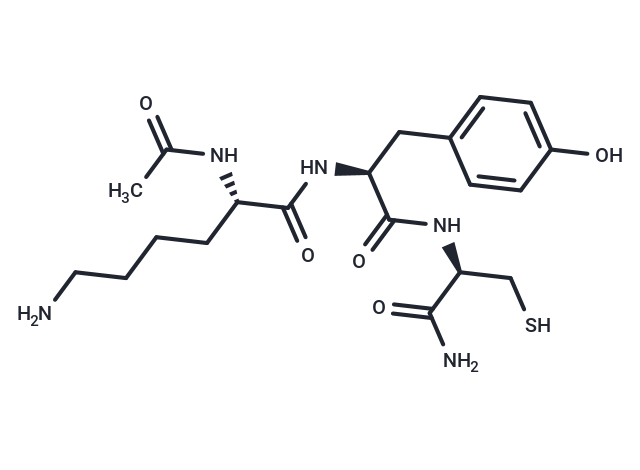Shopping Cart
Remove All Your shopping cart is currently empty
Your shopping cart is currently empty
N-Acetyl lysyltyrosylcysteine amide is a non-toxic, potent, reversible, and specific myeloperoxidase (MPO) tripeptide inhibitor that effectively inhibits MPO production in vivo, attenuates neuronal damage, preserves brain tissue and neurological function post-stroke, and inhibits MPO-dependent hypochlorite (HOCl) production, protein nitration, and LDL oxidation. It is also used in the study of bronchial dysplasia.

| Pack Size | Price | USA Warehouse | Global Warehouse | Quantity |
|---|---|---|---|---|
| 1 mg | $72 | In Stock | In Stock | |
| 5 mg | $183 | In Stock | In Stock | |
| 10 mg | $313 | In Stock | In Stock | |
| 25 mg | $528 | In Stock | In Stock | |
| 50 mg | $753 | In Stock | In Stock | |
| 100 mg | $987 | In Stock | - | |
| 500 mg | $1,980 | Inquiry | Inquiry |
| Description | N-Acetyl lysyltyrosylcysteine amide is a non-toxic, potent, reversible, and specific myeloperoxidase (MPO) tripeptide inhibitor that effectively inhibits MPO production in vivo, attenuates neuronal damage, preserves brain tissue and neurological function post-stroke, and inhibits MPO-dependent hypochlorite (HOCl) production, protein nitration, and LDL oxidation. It is also used in the study of bronchial dysplasia. |
| In vivo | N-Acetyl lysyltyrosylcysteine amide (KYC) (10 mg/kg; i.p.; daily for 3-7 days; C57BL/6J mice) significantly reduces neurological severity scores and infarct size in MCAO mice.[1] N-Acetyl lysyltyrosylcysteine amide (10 mg/kg; i.p.; daily for 7 days) significantly protects BBB function and decreased neutrophil infiltration.[1] N-Acetyl lysyltyrosylcysteine amide (10 mg/kg; i.p.; daily for 7 days; C57BL/6J mice) significantly reduces microglia/macrophage activation and neuron loss in MCAO mice.[1] N-Acetyl lysyltyrosylcysteine amide (10 mg/kg; i.p.; daily for 3-7 days; C57BL/6J mice) decreases apoptosis and cell injury in the brains of MCAO mice.[1] N-Acetyl lysyltyrosylcysteine amide reduced MPO in the brains of MCAO mice. N-Acetyl lysyltyrosylcysteine amide reduces NO2Tyr and 4-HNE in MCAO mice. N-Acetyl lysyltyrosylcysteine amide significantly decreases infarct size, blood-brain barrier leakage, infiltration of myeloid cells, loss of neurons, and apoptosis in the brains of middle cerebral artery occlusion (MCAO) mice.[1] |
| Molecular Weight | 453.56 |
| Formula | C20H31N5O5S |
| Cas No. | 1287585-40-3 |
| Smiles | [C@@H](CC1=CC=C(O)C=C1)(NC([C@H](CCCCN)NC(C)=O)=O)C(N[C@H](C(N)=O)CS)=O |
| Relative Density. | 1.273 g/cm3 (Predicted) |
| Sequence | Ac-Lys-Tyr-Cys-NH2 |
| Sequence Short | KYC |
| Storage | store at low temperature | Powder: -20°C for 3 years | In solvent: -80°C for 1 year | Shipping with blue ice/Shipping at ambient temperature. | |||||||||||||||||||||||||||||||||||
| Solubility Information | DMSO: 55 mg/mL (121.26 mM), Sonication is recommended. | |||||||||||||||||||||||||||||||||||
Solution Preparation Table | ||||||||||||||||||||||||||||||||||||
DMSO
| ||||||||||||||||||||||||||||||||||||
| Size | Quantity | Unit Price | Amount | Operation |
|---|

Copyright © 2015-2026 TargetMol Chemicals Inc. All Rights Reserved.